1) Philips Respironics V60
The Philips Respironics V60 is a type of ventilator that utilizes advanced technology to provide both non-invasive and invasive support for breathing in both adult and pediatric patients. It uses a microprocessor to control the delivery of bilevel positive airway pressure (BiPAP), which is a method of providing positive pressure ventilation. It is one of the best ventilators. This allows for effective breathing assistance without the need for invasive procedures. The V60 is designed for use in both clinical and home settings.
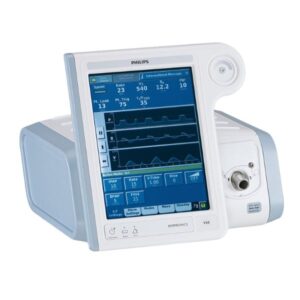
Features: –
- Volume-control ventilation: allows for customizable breath delivery
- Opti-Vent technology: automatically adjusts to the patient’s breathing pattern for optimal comfort and efficiency
- Auto-Trak sensitivity: continuously monitors and adjusts pressure delivery to ensure a proper seal
- Leak compensation: automatically adjust pressure delivery to compensate for any leaks in the system
- Advanced event detection: alerts the user to potential issues, such as apneas or disconnections
- Compatible with the System One platform, allowing for data tracking and analysis.
2) GE Healthcare Engstrom Carestation
This ventilator is known for its compact design and ease of use, making it ideal for use in both the ICU and transport settings. It features a user-friendly interface, advanced monitoring capabilities, and a built-in compressor.
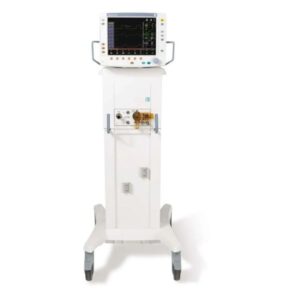
Features: –
- Compact, modular design
- Integrated touchscreen display
- Multiple ventilation modes, including volume control, pressure control, and pressure support
- Built-in oxygen blender
- Adult and pediatric patient settings
- Real-time pressure and flow waveform display
- Optional integrated spirometry and capnography
- Can be used as a transport ventilator
- Battery operation capability for use during transport or power outages
- Remote monitoring and data collection capabilities via GE’s “Insight” software
3) Drager Evita XL
This ventilator is designed for use in the ICU and features advanced modes of ventilation, including volume control, pressure support, and pressure control ventilation (PCV) which allows the user to set a specific pressure level for the patient.
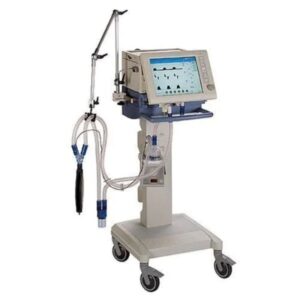
Features: –
- Advanced ventilation modes, including volume-controlled ventilation, pressure-controlled ventilation, pressure support, and synchronized intermittent mandatory ventilation
- Built-in oxygen blender
- Adult and pediatric patient settings
- Real-time pressure and flow waveform display
- Integrated spirometry and capnography
- Can be used as a transport ventilator
- Battery operation capability for use during transport or power outages
- Remote monitoring and data collection capabilities via Dräger’s “XDS” software
- User-friendly, intuitive interface with a color touchscreen display
- Compact, durable design
- Multiple alarm options including visual and auditory alarms
- Multiple languages support
- Automatic self-test and calibration
- Data management via USB or Ethernet interface
- Compliance monitoring with Dräger’s “VentCare” software
- Interoperability with other devices and systems through the use of industry-standard interfaces.
4) Hamilton Medical G5
This ventilator is designed for use in the ICU and features advanced modes of ventilation, including volume control and pressure support. It offers a wide range of ventilation modes and options for adult, pediatric, and neonatal patients.

Features: –
- Compact and portable design
- Real-time ventilation data display
- Advanced monitoring and alarm capabilities
- Built-in oxygen blender and suction unit
- Integrated spirometry and gas analysis
- Automatic and manual ventilation modes
- Adult, pediatric, and neonatal patient settings
- Automatic tube compensation
- Automatic leak compensation
- Can be used with a variety of interfaces, including invasive and non-invasive ventilation.
- Can be integrated with other medical equipment and electronic medical records systems
- Battery operation for use in transport and emergencies
- Bluetooth and USB connectivity for data transfer and software updates
5) ResMed Astral
This ventilator is designed for use in the home and features advanced modes of ventilation, including volume control, pressure support, and Bi-level pressure support (BiPAP) which delivers two different pressure levels during inhalation and exhalation.
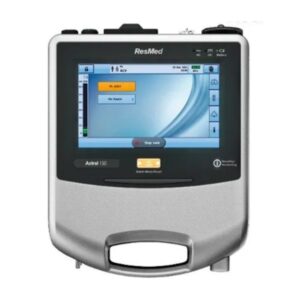
Features: –
- Utilized for both types of ventilation, whether it involves the insertion of a tube or not.
- Built-in wireless connectivity, allowing for remote patient monitoring and adjustments to therapy
- Color touchscreen display, making it easy to navigate and adjust settings
- Built-in humidifier and heated tubing options
- Used with a wide range of mask types, including full-face, nasal, and nasal pillow masks
- Automatic leak compensation feature, which adjusts the pressure to account for any leaks in the system
- Can store and display detailed data on patient therapy usage and compliance
- Built-in alarm system that can alert caregivers to potential issues, such as power failure or high/low pressure
- Lightweight and portable design, making it easy to transport for use at home or on the go
- Battery backup, allowing patients to continue therapy during power outages.
6) Covidien Puritan Bennett 840
This ventilator is designed for use in the ICU and features advanced modes of ventilation, including volume control and pressure support.
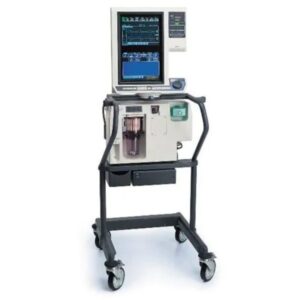
Features: –
- Compact, lightweight design
- Intuitive user interface
- Continuous and automatic leak compensation
- Multiple alarms, including low and high pressure, apnea, and patient disconnect
- Real-time graphic display of pressure, flow, and tidal volume
- Auto-trak sensitivity for spontaneous breathing
- Automatic altitude compensation
- Built-in humidifier
- Adult, pediatric, and neonatal modes
- Used for both invasive and non-invasive ventilation
- Multiple languages supported
- Available with integrated or standalone CO2 monitoring
- Battery backup option available
- Used in both hospital and home settings
- Interface with electronic medical records and other hospital systems
- Data storage capability for long-term monitoring and review
7) Medtronic Trilogy
This ventilator is designed for use in the home and features advanced modes of ventilation, including volume control and pressure support.
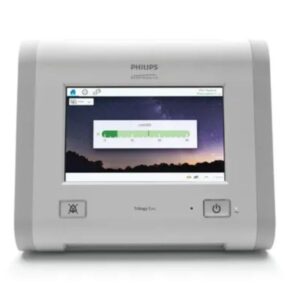
Features: –
- Provides ventilation support for adult and pediatric patients
- Used for both invasive and non-invasive ventilation
- Built-in air compressor and oxygen blender
- Features pressure and volume control modes
- Automatic tube compensation
- Automatic leak compensation
- Alarm system for high and low pressure, power failure, and other issues
- Built-in battery backup
- Built-in data logging and trending capabilities
- User-friendly interface with a color touchscreen display
- Built-in wireless connectivity options
- Integrated with other medical devices, such as patient monitoring systems
- Compact and lightweight design
- Used in both hospital and home care settings.
8) Maquet Servo-i
This ventilator is designed for use in the ICU and features advanced modes of ventilation, including volume control and pressure support.
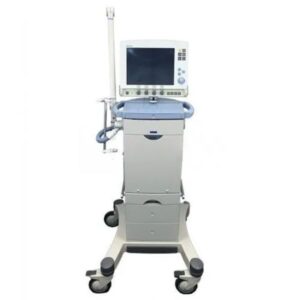
Features: –
- Compact and portable design
- Automatic ventilation system
- Adjustable pressure and flow settings
- Real-time monitoring of patient data
- Multiple safety features, including automatic alarms and self-diagnostics
- Suitable for use in both hospital and pre-hospital settings
- Used for both adult and pediatric patients
- Used for both invasive and non-invasive ventilation
- Employed with various ventilation methods, such as VCV, PCV, SIMV, and CPAP/BiPAP.
- Integrated with other medical equipment, such as monitors and ventilators.
9) Zoll Medical Corp. Propaq
This ventilator is designed for use in transport and features advanced modes of ventilation, including volume control and pressure support.

Features: –
- Portable, lightweight design
- Dual-lead ECG display
- Non-invasive blood pressure measurement
- 3-lead or 5-lead ECG options
- Built-in rechargeable battery
- Suitable for adult, pediatric, and neonatal patients
- Optional accessories such as a thermal printer, carrying case, and carrying strap
- Can store up to 1000 ECG and patient data
- Has the capability of wireless data transfer
- Used for monitoring, transport, and emergency care settings.
10) Fisher & Paykel V60
This ventilator is designed for use in the home and features advanced modes of ventilation, including volume control and pressure support.

Features: –
- Non-invasive, bi-level positive airway pressure (BiPAP) ventilator
- Suitable for both adult and child patients.
- Utilized for both types of ventilation, whether it involves the insertion of a tube or not.
- Utilized for both short-term and long-term breathing difficulties.
- Built-in oxygen blender, humidifier and heated breathing tube
- Used for both volume and pressure control ventilation
- Color touch screen display
- Built-in alarm system
- Integrated data management system.
Also Read – 20 Best Patient Monitors in 2023
11) CareFusion LTV 1200
This ventilator is designed for use in transport and features advanced modes of ventilation, including volume control and pressure support.
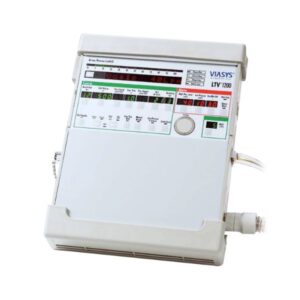
Features: –
- 12.1-inch color touchscreen display
- Suction and oxygen flow control
- Built-in nebulizer, vacuum regulator, oxygen flush, humidifier and suction regulator
- Leak-proof suction canister
- Audible and visual alarms
- Compact and portable design
- Multiple language support
- Suitable for both adult and child patients.
- Battery backup for up to 4 hours of continuous operation
- Suction flow rate of up to 60 LPM
- Oxygen flow rate of up to 15 LPM
- Nebulizer flow rate of up to 7.5 LPM
- Can be used with a variety of suction catheters and nebulizer kits
- Auto shut off feature when canister is full
- Multiple safety features to prevent over-suctioning, over-heating, and low oxygen levels.
12) The Monnal T60
It is a versatile and portable device for mobile medical treatments, designed to provide the highest level of respiratory support in a timely manner. It is an ideal solution for medical teams that need to provide quick and safe healthcare in various settings, such as hospitals, homes, or during transport. The Monnal T60 is easy to adapt to different environments and is equipped with advanced features like a built-in compressor, touch screen interface, real-time monitoring of oxygen saturation, and a built-in humidification system.
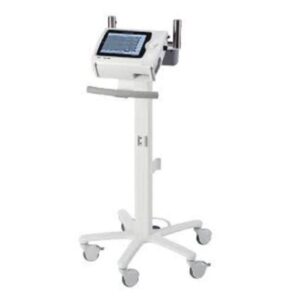
Features: –
- It can deliver up to 60 L/min of oxygen flow
- Equipped with a built-in compressor that allows for continuous operation, also can be powered by an external source
- Suitable for both adult and child patients.
- Utilized with various types of nasal tubing and face masks.
- Built-in battery with a long autonomy time (up to 8 hours)
- Low noise level
- Built-in trolley and handle for ease of transport
- Automatic safety shut-off feature in case of power failure or low battery
- Can be used in various settings like hospital, home, or transport.
13) Siemens Servo 300A
This ventilator is designed for use in the ICU and features advanced modes of ventilation, including volume control and pressure support.
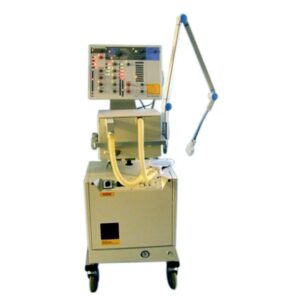
Features: –
- It can provide both invasive and non-invasive ventilation
- Equipped with a color touch screen display for easy operation
- Wide range of ventilation modes, including volume control, pressure control, pressure support, SIMV and CPAP
- Built-in oxygen blender which allows for precise oxygen concentration control
- Suitable for both adult and child patients.
- Built-in spirometry, gas analyzer for monitoring of CO2, O2, and N2O
- Has the ability to connect to external devices such as a patient monitor, spirometer, and capnograph
- Built-in alarm system for high and low pressure, apnea, high and low tidal volume, and high and low minute volume
- Built-in battery for use during transport.
14) Draeger Evita 4
This ventilator is designed for use in the ICU and features advanced modes of ventilation, including volume control and pressure support.

Features: –
- Advanced ventilation system with integrated monitoring and alarms
- Multiple ventilation modes including volume control ventilation, pressure control ventilation, and SIMV
- Built-in oxygen blender with accuracy of ±2%
- Suitable for both adult and child patients..
- Compact and portable design
- Color touchscreen display with intuitive user interface
- Built-in battery backup for operation during power outages
- Can be integrated with other medical equipment such as anesthesia machines and ventilator management software
- Optional accessories include a heated humidifier and a nebulizer.
15) PB 840
The Puritan Bennett 840 is an advanced ventilation system that features the PAV+ software, which enables a more natural breathing pattern for patients, making it easier for them to breathe. It can provide ventilation for patients of all ages, including neonates and adults.
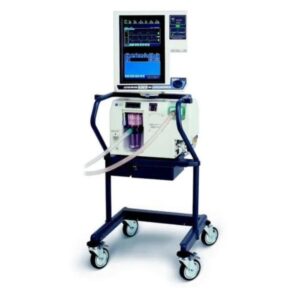
Features: –
- Advanced ICU ventilator with multiple ventilation modes
- Used for both adult and pediatric patients
- Volume control ventilation (VCV), pressure control ventilation (PCV), pressure support ventilation (PSV) and SIMV with pressure support.
- Built-in oxygen blended with accuracy of ±2%
- Color touchscreen display with intuitive user interface
- Integrated with other medical equipment such as anesthesia machines and ventilator management software
- Optional accessories include a heated humidifier and a nebulizer
- Used in both invasive and non-invasive ventilation.
16) Mindray SV300
This ventilator is designed for use in the ICU and features advanced modes of ventilation, including volume control and pressure support.
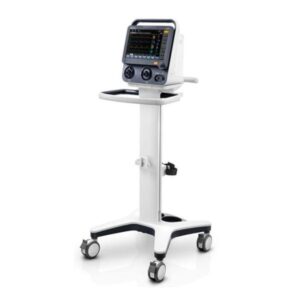
Features: –
- Volume and pressure control modes
- Automatic tube compensation
- Built-in oxygen blender
- Real-time monitoring of pressure, flow, and volume
- Multiple trigger options
- Built-in suction function
- Automatic altitude compensation
- Easy to read color LCD display
- Multiple language support
- Compact and portable design
- Battery backup for operation during power outages
- Data storage and analysis capabilities
- Low maintenance design
17) Bellavista 1000e Ventilator
This ventilator is designed for use in the ICU and features advanced modes of ventilation, including volume control and pressure support. It offers a wide range of ventilation modes and options for adult, pediatric, and neonatal patients.

Features: –
- This ventilator is designed for use in the ICU for patients from neonates to adults.
- It features a large, 17.3-inch touchscreen with an intuitive user interface.
- The ventilator has a mode called Adaptive Ventilation which allows the machine to adjust to the patient’s needs.
- Capability of providing High Flow Oxygen Therapy, as well as advanced Non-Invasive Ventilation (NIV) features. It also has a tool called Lung Recruitment, which helps to open up collapsed lung areas.
- The device is designed to have a minimum battery life of 3 hours and it can be used in case of power outages.
18) Aeonmed Aeon 7100
Ventilator with a built-in monitoring system for inspired oxygen, airway pressure and exhaled volume.
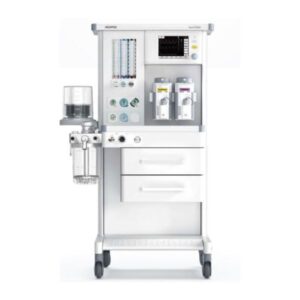
Features:-
- High-performance ventilator with advanced features
- Used for both invasive and non-invasive ventilation
- Suitable for adult, pediatric, and neonatal patients
- Multiple ventilation modes, including volume control, pressure control, and pressure support
- Adjustable tidal volume, inspiratory time, and PEEP settings
- Built-in oxygen blender and suction system
- Real-time monitoring of patient parameters, including flow, pressure, and oxygen saturation
- Automatic alarm and warning system
- Compact and portable design
- Easy to use, with a user-friendly interface
- Has built-in battery for emergency power
- Has a wide range of settings for patients with different needs
19) LTV 1150
The LTV 1150 ventilator is a versatile and advanced respiratory support device designed to meet the needs of adult, pediatric, and neonatal patients. It equipped the machine with a range of features and capabilities that make it suitable for use in both acute and non-acute care settings. The LTV 1150 offers volume and pressure control modes, automatic tube compensation, an integrated oxygen blender, and a built-in humidifier and heated breathing circuit.
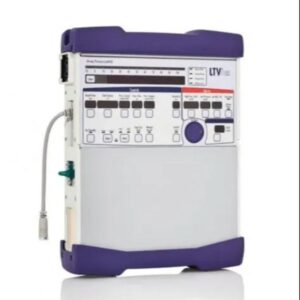
Features: –
- Designed for adult, pediatric, and neonatal patients
- Volume and pressure control modes
- Automatic tube compensation
- Integrated oxygen blender
- Non-invasive and invasive ventilation options
- Built-in humidifier and heated breathing circuit
- Automatic leak compensation
- User-friendly interface with touch screen display
- Multiple alarm options and monitoring capabilities
- Compact and portable design
20) LTV 1100
It is a high-performance, portable machine designed to provide respiratory support for both adult and pediatric patients. With its compact and lightweight design, it is perfect for use in a variety of settings, including hospitals, clinics, and emergency transport.

Features: –
- Compact and portable design, suitable for both adult and pediatric patients
- Multiple ventilation modes, including volume control, pressure control, and SIMV
- Advanced pressure support and spontaneous breathing modes
- Built-in oxygen blended with adjustable FiO2 settings
- Automatic leak compensation
- Real-time monitoring of patient parameters, including pressure, flow, volume, and SpO2
- Alarm system with visual and audible alerts
- Easy-to-use touch screen display
- Built-in battery backup for use during transport
- Can be connected to external devices, such as humidifiers and nebulizers.
Frequently Asked Questions (FAQs)
What is a ventilator?
A ventilator is a medical device that helps patients breathe by providing oxygen to the lungs and removing carbon dioxide from the body. It is used when a patient is unable to breathe on their own, either due to a medical condition or because they are under general anesthesia.
How does a ventilator work?
A ventilator works by delivering a mixture of air and oxygen to the patient’s lungs through a tube that is inserted into the patient’s airway. The machine can be set to provide different levels of pressure and volume of air, depending on the patient’s needs.
Who needs a ventilator?
Ventilators are typically used for patients who are unable to breathe on their own, such as those with severe respiratory infections, lung damage, or neurological conditions that affect the muscles used for breathing.
Are there risks associated with being on a ventilator?
Yes, there are risks associated with being on a ventilator, including lung damage, pneumonia, and other infections. Additionally, being on a ventilator for an extended period of time can lead to muscle weakness and other complications.
How long can someone be on a ventilator?
The length of time someone can be on a ventilator varies depending on the individual patient and their medical condition.
How much does a ventilator cost?
The cost of a ventilator can vary widely depending on the model and features.
Can anyone operate a ventilator?
No, operating a ventilator requires specialized training and knowledge of respiratory care. Only trained medical professionals, such as respiratory therapists and critical care nurses, are qualified to operate a ventilator.
Can a ventilator cure COVID-19?
A ventilator is not a cure for COVID-19, but it can help support a patient’s breathing while their body fights the virus. Ventilators are often used for patients with severe cases of COVID-19 who are experiencing respiratory failure.
Can a ventilator be used at home?
Ventilators are typically used in hospitals or other medical settings, but there are portable ventilators that can be used at home with proper training and monitoring by a medical professional.
How has the COVID-19 pandemic impacted the demand for ventilators?
The COVID-19 pandemic has led to a significant increase in the demand for ventilators, as many patients with severe cases of the virus require support for their breathing.
Are there different types of ventilators?
Yes, there are different types of ventilators that are designed for specific patient needs. For example, some ventilators are designed for neonatal patients, while others are designed for adults.
How are ventilators maintained?
Ventilators require regular maintenance and cleaning to ensure they are functioning properly and to prevent the spread of infection. This includes cleaning and disinfecting the machine, replacing filters, and checking for any mechanical issues.
Can a patient communicate while on a ventilator?
Depending on the type of ventilator and the patient’s condition, it may be possible for a patient to communicate while on a ventilator. However, some patients may experience difficulty speaking due to the tube in their airway.
How long does it take to wean a patient off a ventilator?
The process of weaning a patient off a ventilator can vary depending on the patient’s condition, but it typically takes several days to a few weeks. The goal is to gradually decrease the support provided by the ventilator as the patient’s breathing improves.
What is the difference between a ventilator and a respirator?
The terms “ventilator” and “respirator” are often used interchangeably, but they actually refer to two different types of medical devices. A ventilator is a machine that helps a patient breathe, while a respirator is a mask or other device that filters the air a patient breathes.
References
- https://www.vyaire.com/products/bellavista-1000e-ventilator
- https://www.mindray.com/en/products/ventilators/sv300
- https://www.medtronic.com/covidien/en-us/products/mechanical-ventilation/puritan-bennett-840-ventilator.html
- https://www.somatechnology.com/Ventilators/Drager-Evita-4.aspx

Hi, I’m the Founder and Developer of Paramedics World, a blog truly devoted to Paramedics. I am a Medical Lab Tech, a Web Developer and Bibliophiliac. My greatest hobby is to teach and motivate other peoples to do whatever they wanna do in life.